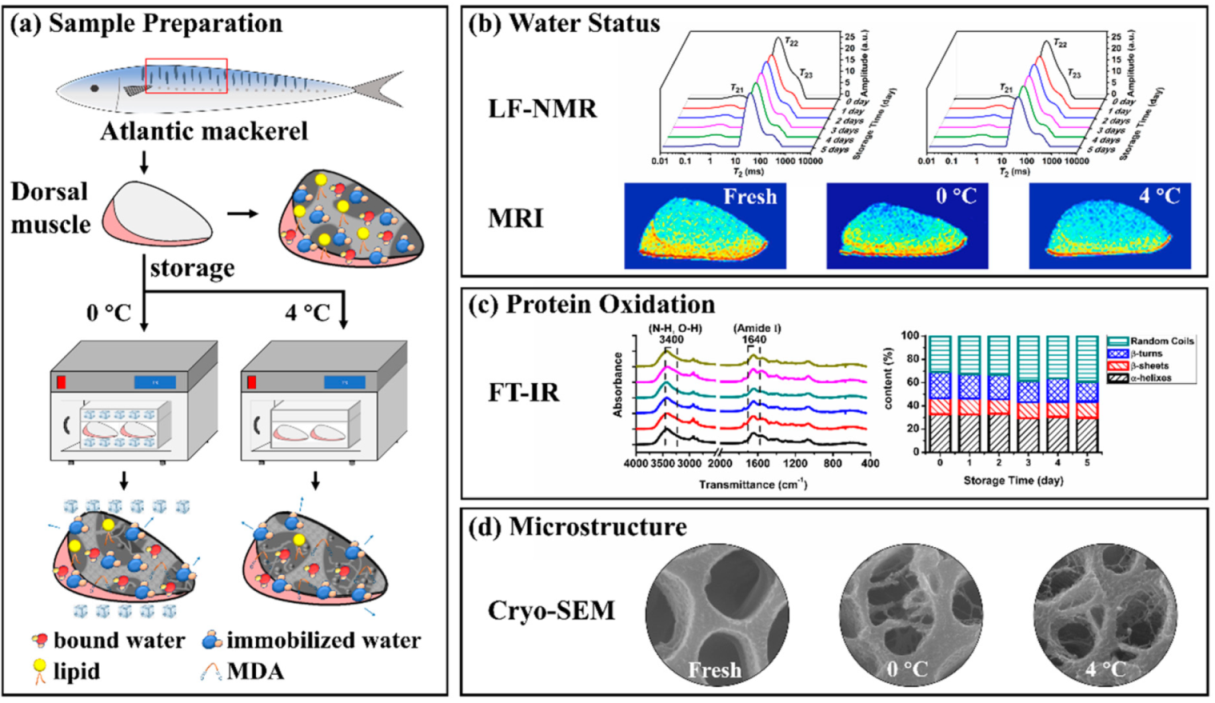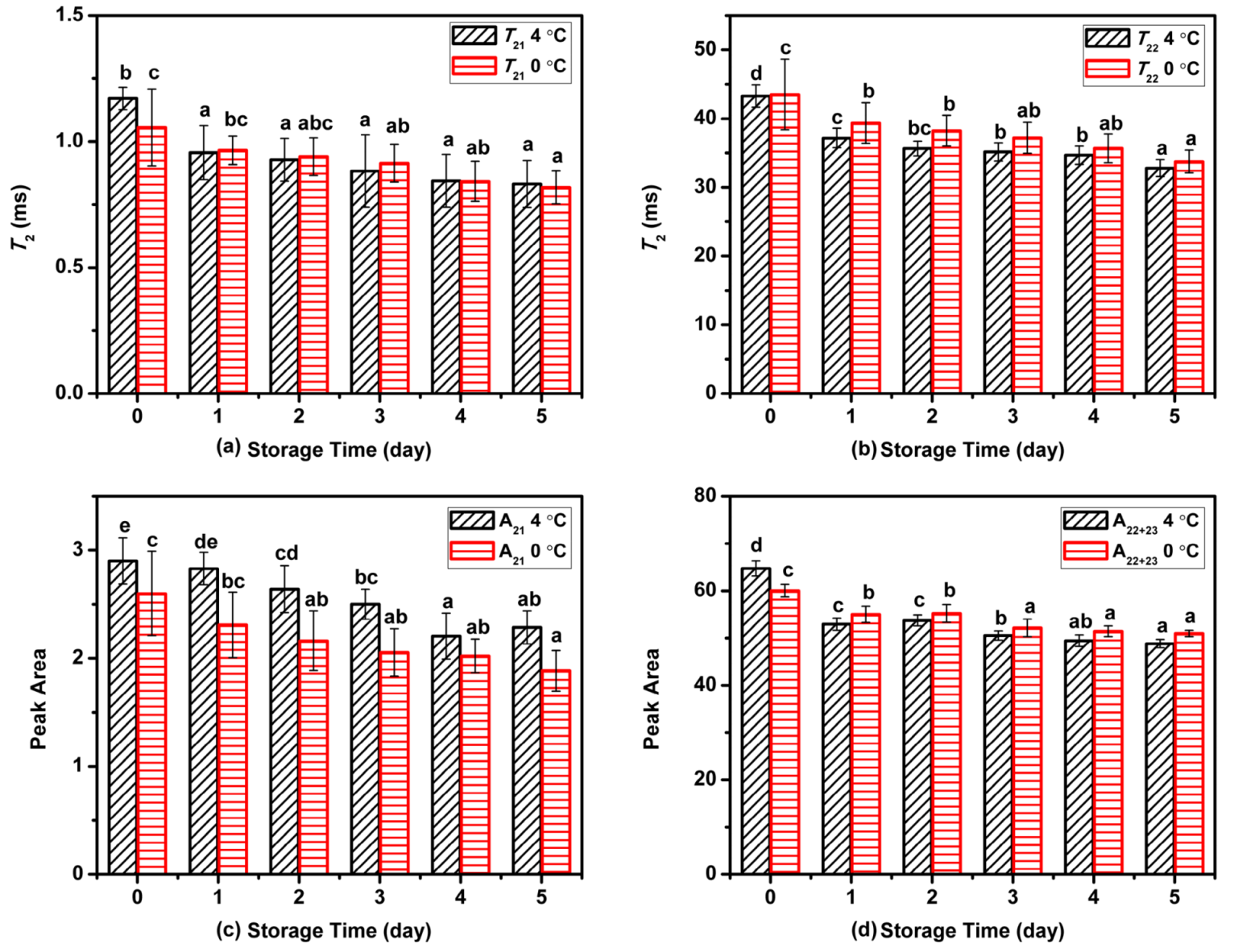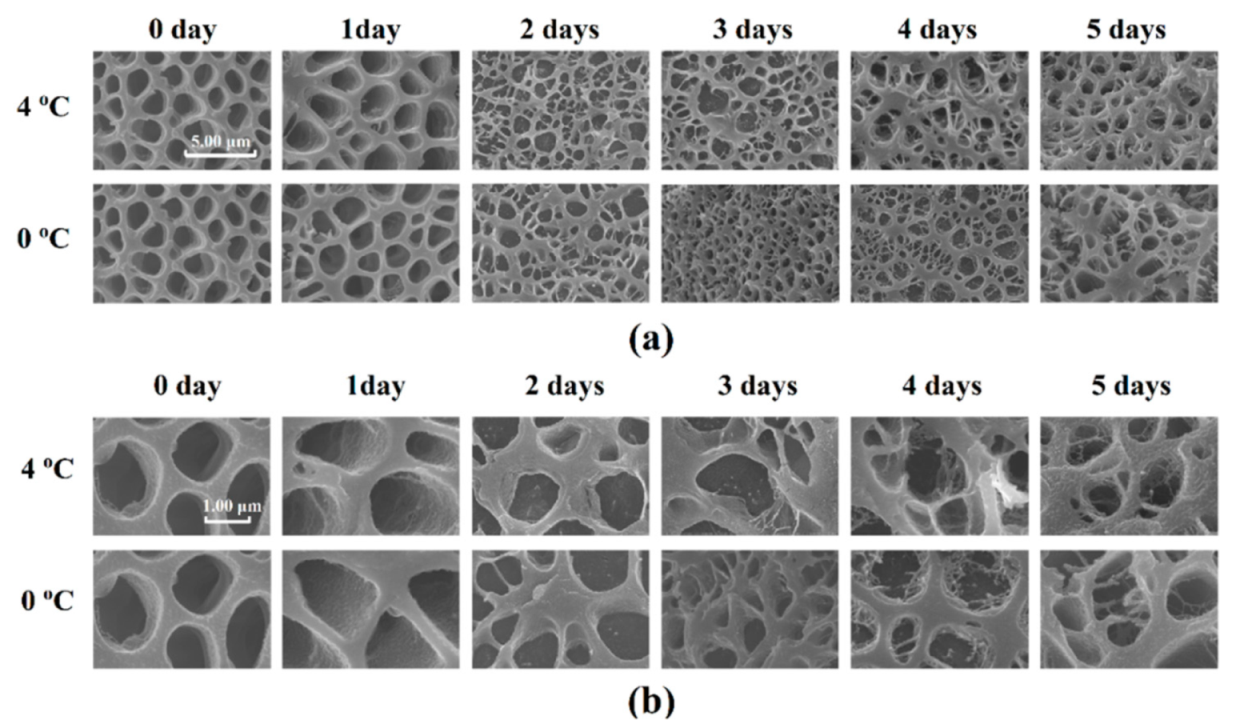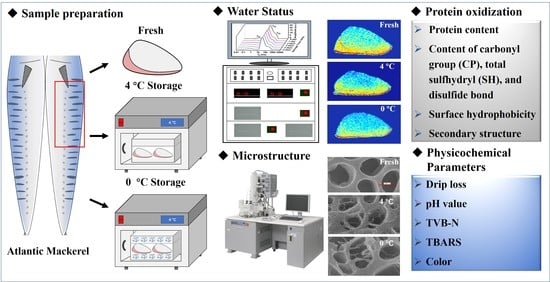Influence of Refrigerated Storage on Water Status, Protein Oxidation, Microstructure, and Physicochemical Qualities of Atlantic Mackerel (Scomber scombrus)
Abstract
:1. Introduction
2. Materials and Methods
2.1. Sample Preparation
2.2. Low-Field Nuclear Magnetic Resonance (LF-NMR) and Magnetic Resonance Imaging (MRI) Measurements
2.3. Protein Oxidation
2.3.1. Protein Extraction
2.3.2. Analysis of Carbonyl Group (CP) Content, Total Sulfhydryl (SH) Content, Disulfide Bond Content, and Surface Hydrophobicity
2.3.3. Fourier Transform Infrared (FTIR) Spectra
2.4. Microstructure
2.5. Physicochemical Parameters
2.5.1. Drip Loss
2.5.2. pH Value
2.5.3. Total Volatile Basic Nitrogen (TVB-N)
2.5.4. Thiobarbituric Acid-Reactive Substances (TBARS)
2.6. Color Measurement
2.7. Statistical Analysis
3. Results
3.1. LF-NMR and MRI Analysis
3.2. Protein Oxidation Analysis
3.3. Secondary Structure Change of Atlantic Mackerel Protein
3.4. Microstructure Analysis
3.5. Physicochemical Analysis
3.6. Color Analysis
3.7. Correlation Analysis between Protein Oxidation, Physicochemical Qualities, and Water Status
4. Conclusions
Supplementary Materials
Author Contributions
Funding
Institutional Review Board Statement
Informed Consent Statement
Data Availability Statement
Conflicts of Interest
References
- Romotowska, P.E.; Gudjonsdottir, M.; Karlsdottir, M.G.; Kristinsson, H.G.; Arason, S. Stability of frozen atlantic mackerel (Scomber scombrus) as affected by temperature abuse during transportation. LWT Food Sci. Technol. 2017, 83, 275–282. [Google Scholar] [CrossRef]
- Maestre, R.; Pazos, M.; Medina, I. Role of the raw composition of pelagic fish muscle on the development of lipid oxidation and rancidity during storage. J. Agric. Food Chem. 2011, 59, 6284–6291. [Google Scholar] [CrossRef]
- Romotowska, P.E.; Karlsdóttir, M.G.; Gudjónsdóttir, M.; Kristinsson, H.G.; Arason, S. Seasonal and geographical variation in chemical composition and lipid stability of Atlantic mackerel (Scomber scombrus) caught in icelandic waters. J. Food Compos. Anal. 2016, 49, 9–18. [Google Scholar] [CrossRef]
- Mohan, C.O.; Ravishankar, C.N.; Lalitha, K.; Gopal, T.S. Effect of chitosan edible coating on the quality of double filleted Indian oil sardine (Sardinella longiceps) during chilled storage. Food Hydrocoll. 2012, 26, 167–174. [Google Scholar] [CrossRef]
- Truong, B.Q.; Buckow, R.; Nguyen, M.H.; Stathopoulos, C.E. High pressure processing of barramundi (Lates calcarifer) muscle before freezing: The effects on selected physicochemical properties during frozen storage. J. Food Eng. 2016, 169, 72–78. [Google Scholar] [CrossRef]
- Bono, G.; Okpala, C.O.R.; Vitale, S.; Ferrantelli, V.; Di Noto, A.; Costa, A.; Di Bella, C.; Monaco, D.L. Effects of different ozonized slurry-ice treatments and superchilling storage (−1 °C) on microbial spoilage of two important pelagic fish species. Food Sci. Nutr. 2017, 5, 1049–1056. [Google Scholar] [CrossRef] [Green Version]
- Yu, D.; Wu, L.; Regenstein, J.M.; Jiang, Q.; Yang, F.; Xu, Y.; Xia, W. Recent advances in quality retention of non-frozen fish and fishery products: A review. Crit. Rev. Food Sci. Nutr. 2020, 60, 1747–1759. [Google Scholar] [CrossRef]
- Pearce, K.; Rosenvold, K.; Andersen, H.J.; Hopkins, D.L. Water distribution and mobility in meat during the conversion of muscle to meat and ageing and the impacts on fresh meat quality attributes—A review. Meat Sci. 2011, 89, 111–124. [Google Scholar] [CrossRef]
- Marcone, M.F.; Wang, S.; Albabish, W.; Nie, S.; Somnarain, D.; Hill, A. Diverse food-based applications of nuclear magnetic resonance (NMR) technology. Food Res. Int. 2013, 51, 729–747. [Google Scholar] [CrossRef]
- Belton, P. Spectroscopic Approaches to the Understanding of Water in Foods. Food Rev. Int. 2011, 27, 170–191. [Google Scholar] [CrossRef]
- Andersen, C.M.; J⊘Rgensen, B.M. On the Relation Between Water Pools and Water Holding Capacity in Cod Muscle. J. Aquat. Food Prod. Technol. 2004, 13, 13–23. [Google Scholar] [CrossRef]
- Sánchez-Alonso, I.; Martinez, I.; Valencia, J.R.S.; Careche, M. Estimation of freezing storage time and quality changes in hake (Merluccius merluccius, L.) by low field NMR. Food Chem. 2012, 135, 1626–1634. [Google Scholar] [CrossRef] [Green Version]
- Sánchez-Alonso, I.; Moreno, P.; Careche, M. Low field nuclear magnetic resonance (LF-NMR) relaxometry in hake (Merluccius merluccius, L.) muscle after different freezing and storage conditions. Food Chem. 2014, 153, 250–257. [Google Scholar] [CrossRef]
- Sánchez-Valencia, J.; Sánchez-Alonso, I.; Martinez, I.; Careche, M. Low-Field Nuclear Magnetic Resonance of Proton (1H LF NMR) Relaxometry for Monitoring the Time and Temperature History of Frozen Hake (Merluccius merluccius L.) Muscle. Food Bioprocess Technol. 2015, 8, 2137–2145. [Google Scholar] [CrossRef] [Green Version]
- Xu, Y.; Song, M.; Xia, W.; Jiang, Q. Effects of freezing method on water distribution, microstructure, and taste active compounds of frozen channel catfish (Ictalurus punctatus). J. Food Process Eng. 2018, 42, e12937. [Google Scholar] [CrossRef] [Green Version]
- Sun, Q.; Sun, F.; Xia, X.; Xu, H.; Kong, B. The comparison of ultrasound-assisted immersion freezing, air freezing and immersion freezing on the muscle quality and physicochemical properties of common carp (Cyprinus carpio) during freezing storage. Ultrason. Sonochem. 2019, 51, 281–291. [Google Scholar] [CrossRef]
- Qin, N.; Zhang, L.; Zhang, J.; Song, S.; Wang, Z.; Regenstein, J.M.; Luo, Y. Influence of lightly salting and sugaring on the quality and water distribution of grass carp (Ctenopharyngodon idellus) during super-chilled storage. J. Food Eng. 2017, 215, 104–112. [Google Scholar] [CrossRef]
- Sun, Y.; Ma, L.; Ma, M.; Zheng, H.; Zhang, X.; Cai, L.; Li, J.; Zhang, Y. Texture characteristics of chilled prepared Mandarin fish (Siniperca chuatsi) during storage. Int. J. Food Prop. 2018, 21, 242–254. [Google Scholar] [CrossRef] [Green Version]
- Wang, S.; Xiang, W.; Fan, H.; Xie, J.; Qian, Y. Study on the mobility of water and its correlation with the spoilage process of salmon (Salmo solar) stored at 0 and 4 °C by low-field nuclear magnetic resonance (LF NMR 1H). J. Food Sci. Technol. 2018, 55, 173–182. [Google Scholar] [CrossRef]
- Wang, X.-Y.; Xie, J. Evaluation of water dynamics and protein changes in bigeye tuna (Thunnus obesus) during cold storage. LWT Food Sci. Technol. 2019, 108, 289–296. [Google Scholar] [CrossRef]
- Gudjónsdóttir, M.; Lauzon, H.L.; Magnússon, H.; Sveinsdóttir, K.; Arason, S.; Martinsdóttir, E.; Rustad, T. Low field Nuclear Magnetic Resonance on the effect of salt and modified atmosphere packaging on cod (Gadus morhua) during superchilled storage. Food Res. Int. 2011, 44, 241–249. [Google Scholar] [CrossRef]
- Gudjónsdóttir, M.; Romotowska, P.E.; Karlsdóttir, M.G.; Arason, S. Low field nuclear magnetic resonance and multivariate analysis for prediction of physicochemical characteristics of Atlantic mackerel as affected by season of catch, freezing method, and frozen storage duration. Food Res. Int. 2019, 116, 471–482. [Google Scholar] [CrossRef]
- Yang, F.; Jia, S.; Liu, J.; Gao, P.; Yu, D.; Jiang, Q.; Xu, Y.; Yu, P.; Xia, W.; Zhan, X. The relationship between degradation of myofibrillar structural proteins and texture of superchilled grass carp (Ctenopharyngodon idella) fillet. Food Chem. 2019, 301, 125278. [Google Scholar] [CrossRef]
- Barraza, F.A.A.; León, R.A.Q.; Álvarez, P.X.L. Kinetics of protein and textural changes in Atlantic salmon under frozen storage. Food Chem. 2015, 182, 120–127. [Google Scholar] [CrossRef]
- Shi, L.; Yang, T.; Xiong, G.; Li, X.; Wang, X.; Ding, A.; Qiao, Y.; Wu, W.; Liao, L.; Wang, L. Influence of frozen storage temperature on the microstructures and physicochemical properties of pre-frozen perch (micropterus salmoides). LWT Food Sci. Technol. 2018, 92, 471–476. [Google Scholar] [CrossRef]
- Chomnawang, C.; Nantachai, K.; Yongsawatdigul, J.; Thawornchinsombut, S.; Tungkawachara, S. Chemical and biochemical changes of hybrid catfish fillet stored at 4 °C and its gel properties. Food Chem. 2007, 103, 420–427. [Google Scholar] [CrossRef]
- Sáez, M.I.; Suárez, M.D.; Cárdenas, S.; Martínez, T.F.; Martínez, T.F. Freezing and Freezing-Thawing Cycles on Textural and Biochemical Changes of Meagre (Argyrosomus regius, L.) Fillets During Further Cold Storage. Int. J. Food Prop. 2014, 18, 1635–1647. [Google Scholar] [CrossRef] [Green Version]
- Caballero, M.J.; Betancor, M.; Escrig, J.; Montero, D.; Monteros, A.E.D.L.; Castro, P.; Ginés, R.; Izquierdo, M. Post mortem changes produced in the muscle of sea bream (Sparus aurata) during ice storage. Aquaculture 2009, 291, 210–216. [Google Scholar] [CrossRef]
- Zhang, X.; Huang, W.; Xie, J. Effect of Different Packaging Methods on Protein Oxidation and Degradation of Grouper (Epinephelus coioides) During Refrigerated Storage. Foods 2019, 8, 325. [Google Scholar] [CrossRef] [Green Version]
- Ganhão, R.; Morcuende, D.; Estévez, M. Protein oxidation in emulsified cooked burger patties with added fruit extracts: Influence on colour and texture deterioration during chill storage. Meat Sci. 2010, 85, 402–409. [Google Scholar] [CrossRef]
- Kobayashi, N.P.; Donley, C.L.; Wang, S.-Y.; Williams, R.S. Atomic layer deposition of aluminum oxide on hydrophobic and hydrophilic surfaces. J. Cryst. Growth 2007, 299, 218–222. [Google Scholar] [CrossRef]
- AOAC. Associaation of Official Analytical Chemists: Official Methods of Analysis, 17th ed.; AOAC: Washington, DC, USA; Gaithersburg, MD, USA, 2005. [Google Scholar]
- John, L.; Cornforth, D.; Carpenter, C.E.; Sorheim, O.; Pettee, B.C.; Whittier, D.R. Color and thiobarbituric acid values of cooked top sirloin steaks packaged in modified atmospheres of 80% oxygen, or 0.4% carbon monoxide, or vacuum. Meat Sci. 2005, 69, 441–449. [Google Scholar] [CrossRef]
- Standal, I.B.; Mozuraityte, R.; Rustad, T.; Alinasabhematabadi, L.; Carlsson, N.-G.; Undeland, I. Quality of Filleted Atlantic Mackerel (Scomber Scombrus) During Chilled and Frozen Storage: Changes in Lipids, Vitamin D, Proteins, and Small Metabolites, including Biogenic Amines. J. Aquat. Food Prod. Technol. 2018, 27, 338–357. [Google Scholar] [CrossRef]
- Lu, H.; Wang, H.; Luo, Y. Changes in Protein Oxidation, Water-Holding Capacity, and Texture of Bighead Carp (Aristichthys Nobilis) Fillets Under Chilled and Partial Frozen Storage. J. Aquat. Food Prod. Technol. 2017, 26, 566–577. [Google Scholar] [CrossRef]
- Hematyar, N.; Rustad, T.; Sampels, S.; Dalsgaard, T.K. Relationship between lipid and protein oxidation in fish. Aquac. Res. 2019, 50, 1393–1403. [Google Scholar] [CrossRef]
- Babakhani, A.; Farvin, K.H.S.; Jacobsen, C. Antioxidative Effect of Seaweed Extracts in Chilled Storage of Minced Atlantic Mackerel (Scomber scombrus): Effect on Lipid and Protein Oxidation. Food Bioprocess Technol. 2016, 9, 352–364. [Google Scholar] [CrossRef] [Green Version]
- Pan, J.; Wang, Y.; Xia, L.; Lian, H.; Jin, W.; Li, S.; Qiao, F.; Dong, X. Physiochemical and rheological properties of oxidized Japanese seerfish (Scomberomorus niphonius) myofibrillar protein. J. Food Biochem. 2019, 43, e13079. [Google Scholar] [CrossRef]
- Lu, H.; Zhang, L.; Shi, J.; Wang, Z.; Luo, Y. Effects of frozen storage on physicochemical characteristics of bighead carp (Aristichthys nobilis) fillets. J. Food Process. Preserv. 2019, 43, e14141. [Google Scholar] [CrossRef]
- Duran-Montgé, P.; Permanyer, M.; Belletti, N. Refrigerated or superchilled skin-packed sea bream (Sparus aurata) compared with traditional unpacked storage on ice with regard to physicochemical, microbial and sensory attributes. J. Food Process. Preserv. 2015, 39, 1278–1286. [Google Scholar] [CrossRef]
- Liu, D.; Liang, L.; Xia, W.; Regenstein, J.M.; Zhou, P. Biochemical and physical changes of grass carp (Ctenopharyngodon idella) fillets stored at −3 and 0 °C. Food Chem. 2013, 140, 105–114. [Google Scholar] [CrossRef]
- Otero, L.; Pérez-Mateos, M.; Holgado, F.; Márquez-Ruiz, G.; López-Caballero, M. Hyperbaric cold storage: Pressure as an effective tool for extending the shelf-life of refrigerated mackerel (Scomber scombrus, L.). Innov. Food Sci. Emerg. Technol. 2019, 51, 41–50. [Google Scholar] [CrossRef] [Green Version]
- Cavonius, L.R.; Undeland, I. Glazing herring (Clupea harengus) fillets with herring muscle press juice: Effect on lipid oxidation development during frozen storage. Int. J. Food Sci. Technol. 2017, 52, 1229–1237. [Google Scholar] [CrossRef]
- Duun, A.; Rustad, T. Quality of superchilled vacuum packed Atlantic salmon (Salmo salar) fillets stored at −1.4 and −3.6 °C. Food Chem. 2008, 106, 122–131. [Google Scholar] [CrossRef]









| Storage Time (D) | L* | a* | b* | |||
|---|---|---|---|---|---|---|
| 4 °C | 0 °C | 4 °C | 0 °C | 4 °C | 0 °C | |
| 0 | 45.83 ± 1.51 a | 45.83 ± 1.51 a | −1.67 ± 0.47 a | −1.67 ± 0.47 ab | 7.50 ± 0.50 a | 7.50 ± 0.50 a |
| 1 | 48.71 ± 1.11 b | 47.70 ± 0.56 ab | −1.79 ± 0.47 a | −1.88 ± 0.55 ab | 8.78 ± 0.38 ab | 7.82 ± 1.25 a |
| 2 | 53.46 ± 1.27 c | 50.44 ± 3.18 bc | −1.78 ± 0.19 a | −2.02 ± 0.46 a | 10.88 ± 1.67 bc | 9.22 ± 0.58 a |
| 3 | 54.79 ± 1.13 cd | 51.81 ± 1.35 bc | −1.37 ± 0.72 a | −2.27 ± 0.26 a | 11.52 ± 2.09 cd | 9.86 ± 1.37 ab |
| 4 | 56.57 ± 1.17 de | 54.40 ± 3.99 c | −2.10 ± 0.08 a | −1.08 ± 0.35 b | 11.85 ± 0.29 cd | 11.93 ± 1.80 b |
| 5 | 57.50 ± 1.74 e | 54.87 ± 2.09 c | −1.51 ± 0.56 a | −2.48 ± 0.69 a | 13.70 ± 0.87 e | 12.21 ± 1.56 b |
| Parameter | 4 °C | 0 °C | ||
|---|---|---|---|---|
| T21 | T22 | T21 | T22 | |
| Sarcoplasmic protein content | −0.269 | −0.706 ** | −0.536 * | −0.899 ** |
| Myofibrillar protein content | 0.573 * | 0.832 ** | 0.458 | 0.650 ** |
| Total CP content | −0.638 ** | −0.849 ** | −0.446 | −0.542 * |
| Total SH content | 0.617 ** | 0.856 ** | 0.466 | 0.681 ** |
| Disulfide bond content | −0.242 | −0.597 * | −0.573 * | −0.892 ** |
| Surface hydrophobicity | −0.323 | −0.641 ** | −0.430 | −0.802 ** |
| Drip loss | −0.496 * | −0.750 ** | −0.492 * | −0.792 ** |
| pH | −0.266 | −0.292 | 0.348 | 0.536 * |
| TBARS | −0.427 | −0.822 ** | −0.533 * | −0.754 ** |
| TVB-N | −0.402 | −0.739 ** | −0.535 * | −0.785 ** |
| L* | −0.462 | −0.750 ** | −0.584 * | −0.721 ** |
| a* | −0.203 | −0.760 ** | −0.198 | 0.142 |
| b* | −0.588 * | −0.790 ** | −0.494 * | −0.690 ** |
Publisher’s Note: MDPI stays neutral with regard to jurisdictional claims in published maps and institutional affiliations. |
© 2021 by the authors. Licensee MDPI, Basel, Switzerland. This article is an open access article distributed under the terms and conditions of the Creative Commons Attribution (CC BY) license (http://creativecommons.org/licenses/by/4.0/).
Share and Cite
Lin, R.; Cheng, S.; Wang, S.; Tan, M.; Zhu, B. Influence of Refrigerated Storage on Water Status, Protein Oxidation, Microstructure, and Physicochemical Qualities of Atlantic Mackerel (Scomber scombrus). Foods 2021, 10, 214. https://doi.org/10.3390/foods10020214
Lin R, Cheng S, Wang S, Tan M, Zhu B. Influence of Refrigerated Storage on Water Status, Protein Oxidation, Microstructure, and Physicochemical Qualities of Atlantic Mackerel (Scomber scombrus). Foods. 2021; 10(2):214. https://doi.org/10.3390/foods10020214
Chicago/Turabian StyleLin, Rong, Shasha Cheng, Siqi Wang, Mingqian Tan, and Beiwei Zhu. 2021. "Influence of Refrigerated Storage on Water Status, Protein Oxidation, Microstructure, and Physicochemical Qualities of Atlantic Mackerel (Scomber scombrus)" Foods 10, no. 2: 214. https://doi.org/10.3390/foods10020214







